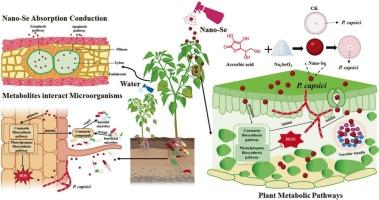Nanoselenium-driven reduction in chemical fungicide usage: Eco-safety enhancement in pepper Phytophthora capsici control
IF 4
1区 农林科学
Q2 BIOCHEMISTRY & MOLECULAR BIOLOGY
引用次数: 0
Abstract
Phytophthora blight, caused by Phytophthora capsici, poses a devastating threat to pepper production, driving heavy reliance on chemical pesticides like azoxystrobin. However, the rapid evolution of fungicide resistance in P. capsici and the environmental risks of conventional agrochemicals demand sustainable alternatives. While nano‑selenium (nano-Se) is known to enhance plant antioxidant capacity and modulate secondary metabolism, its role in regulating plant secondary metabolite-microbe interactions for oomycete resistance remains underexplored. Here, we engineered a nano-Se formulation as a green nanofungicide, demonstrating superior anti-oomycete efficacy (EC50 = 8 mg/L) compared to azoxystrobin and berberine. Nano-Se directly triggered peroxidative damage in P. capsici hyphae, inducing intracellular leakage, respiratory suppression, and irreversible cell death. Bidirectional translocation of nano-Se within pepper plants enhanced systemic antioxidant defenses and growth, while reprogramming coumarin and phenylpropanoid biosynthesis pathways. This metabolic rewiring elevated antifungal coumarins (6-nitrocoumarin, 6-hydroxycoumarin), phytohormones (JA, SA), and phenolic acids (ferulic acid, sinapic acid), with 6-nitrocoumarin (10 mg/L) exhibiting potent P. capsici suppression via dual modulation of redox homeostasis and secondary metabolism. Critically, nano-Se remodeled the rhizosphere microbiome, enriching plant-beneficial taxa and fostering pathogen-suppressive microbial consortia. By synergizing coumarin-mediated antifungal activity with microbiome engineering, nano-Se reduced chemical dependency while enhancing pepper resistance to P. capsici. Our findings provide a mechanistic roadmap for deploying nano-Se as an eco-safe agrochemical, addressing fungicide resistance and environmental hazards in soilborne disease management.

纳米硒驱动化学杀菌剂用量的减少:辣椒疫病防治的生态安全增强
由辣椒疫霉引起的疫病对辣椒生产造成了毁灭性的威胁,导致人们严重依赖偶氮杀菌剂等化学农药。然而,辣椒粉对杀菌剂耐药性的快速进化和传统农用化学品的环境风险需要可持续的替代品。虽然已知纳米硒(nano- se)可以增强植物抗氧化能力和调节次生代谢,但其在调节植物次生代谢物-微生物相互作用对卵霉菌抗性的作用仍未得到充分研究。在这里,我们设计了一种纳米硒制剂作为绿色纳米杀菌剂,与氮嘧菌酯和小檗碱相比,它具有更好的抗卵霉菌功效(EC50 = 8 mg/L)。纳米硒直接引发辣椒辣椒菌丝的过氧化损伤,导致细胞内渗漏、呼吸抑制和不可逆的细胞死亡。纳米硒在辣椒植物中的双向易位增强了系统的抗氧化防御和生长,同时重新编程香豆素和苯丙素的生物合成途径。这种代谢重组提高了抗真菌香豆素(6-硝基香豆素、6-羟基香豆素)、植物激素(JA、SA)和酚酸(阿魏酸、辛酸),其中6-硝基香豆素(10 mg/L)通过氧化还原稳态和次级代谢的双重调节,表现出对辣椒辣椒的有效抑制。关键是,纳米硒重塑了根际微生物群,丰富了植物有益的分类群,培养了抑制病原体的微生物群落。通过香豆素介导的抗真菌活性与微生物组工程的协同作用,纳米硒降低了辣椒对辣椒粉的化学依赖性,同时增强了辣椒对辣椒粉的抗性。我们的研究结果为将纳米硒作为一种生态安全的农用化学品,解决土壤传播疾病管理中的杀菌剂抗性和环境危害提供了一个机制路线图。
本文章由计算机程序翻译,如有差异,请以英文原文为准。
求助全文
约1分钟内获得全文
求助全文
来源期刊
CiteScore
7.00
自引率
8.50%
发文量
238
审稿时长
4.2 months
期刊介绍:
Pesticide Biochemistry and Physiology publishes original scientific articles pertaining to the mode of action of plant protection agents such as insecticides, fungicides, herbicides, and similar compounds, including nonlethal pest control agents, biosynthesis of pheromones, hormones, and plant resistance agents. Manuscripts may include a biochemical, physiological, or molecular study for an understanding of comparative toxicology or selective toxicity of both target and nontarget organisms. Particular interest will be given to studies on the molecular biology of pest control, toxicology, and pesticide resistance.
Research Areas Emphasized Include the Biochemistry and Physiology of:
• Comparative toxicity
• Mode of action
• Pathophysiology
• Plant growth regulators
• Resistance
• Other effects of pesticides on both parasites and hosts.

 求助内容:
求助内容: 应助结果提醒方式:
应助结果提醒方式:


